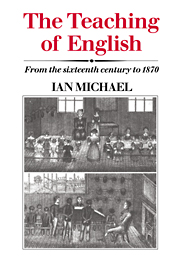Book contents
- Frontmatter
- Contents
- List of tables
- Preface
- 1 The enquiry: scope, method, texts
- 2 Reading, spelling, pronunciation: the elements
- 3 Reading, spelling, pronunciation: the skills
- 4 Interpretation: literature presented
- 5 Interpretation: literature taught
- 6 Expression and performance
- 7 Linguistic control
- 8 English: the development of a subject
- Abbreviations
- Bibliography 1
- Bibliography 2
- Bibliography 3
- Bibliography 4
- Index
3 - Reading, spelling, pronunciation: the skills
Published online by Cambridge University Press: 05 June 2012
- Frontmatter
- Contents
- List of tables
- Preface
- 1 The enquiry: scope, method, texts
- 2 Reading, spelling, pronunciation: the elements
- 3 Reading, spelling, pronunciation: the skills
- 4 Interpretation: literature presented
- 5 Interpretation: literature taught
- 6 Expression and performance
- 7 Linguistic control
- 8 English: the development of a subject
- Abbreviations
- Bibliography 1
- Bibliography 2
- Bibliography 3
- Bibliography 4
- Index
Summary
Kinds of spelling
Until the end of the eighteenth century spelling was often, and from then until the 1830s occasionally, defined just as ‘dividing words into their syllables’:
1580a ‘To divide syllables in a word [is] called spelling.’
(William Bullokar, Booke at Large, p. 44)c. 1625 ‘The dissolution of wordes into syllables commonly termed spelling.’
(Thomas Hay ward, fol. 89b)1710 ‘Q. What is spelling? A. Dividing words into Syllables.’
(John Urmston, 1700, p.5)1825 ‘The division of words into syllables and of letters into syllables is called spelling.’
(Samuel Oliver, p. 7)Unless this meaning of spelling is borne in mind it is impossible to understand, for example, Elisha Coles' boast in the preface to his spellingbook:
1674 ‘The Rule that I lay down is brief and plain and easie: viz. All words must so be spell'd, as they are afterwards to be pronounc'd. But this they [the Masters] dare not venture on, for fear (forsooth) of straying from the common road, or slighting of a rule that was made and intended only for the Latin tongue. See. I have broke the ice.’
Yet Coles' lists of over 6000 words contain no innovatory spellings in our sense of the term; it is in the division of syllables that he is departing from the rules and from Latin precedents.
- Type
- Chapter
- Information
- The Teaching of EnglishFrom the Sixteenth Century to 1870, pp. 90 - 134Publisher: Cambridge University PressPrint publication year: 1987

